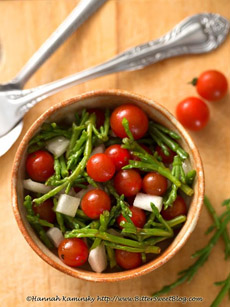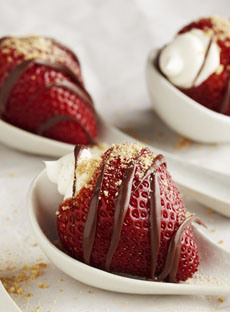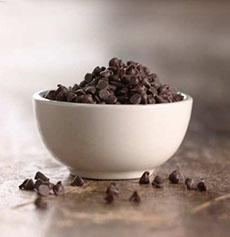|
Today’s tip is: Keep your eyes open for new foods. Then, share them with foodie friends.
Hannah Kaminsky of Bittersweet Blog discovered sea asparagus—a vegetable that grows in or adjacent to salt water—on a recent trip to Hawaii. Sea asparagus grows in warm salt marshes and on beaches, there for the foraging. It is harvested wild, and also cultivated.
What Is Sea Asparagus
Sea asparagus (Salicornia europaea), also known as glasswort, samphire or sea beans, is a tender, green, spindly stalk that resembles tiny land-grown asparagus (although they are not related). It is a member of the Amaranthaceae family, which includes everything from amaranth, a high-protein grain, to ornamental cockscomb and picturesque tumbleweed.
Sea asparagus can be purchased fresh in areas where it is harvested, and packaged in specialty food markets. You can purchase it fresh, frozen, pickled (this year’s stocking stuffer?) and in other forms (sea pesto, powdered seasoning) from Olakai Hawaii. The season in British Columbia is currently “in full swing,” according to West Coast Seaweed, another e-tailer.
Fresh sea asparagus can be eaten raw, pickled or steamed (and then tossed in butter or olive oil); in a salad, as a side dish or a garnish (see the sushi photo below). Dried sea vegetables can be added directly to soups or stews and to the cooking liquid of beans or rice.
|
|

Invite a new vegetable to lunch or dinner. Sea asparagus photo © Hannah Kaminsky | Bittersweet Blog. |
No Extra Salt Required
“Absorbing the sea salt like a sponge, sea asparagus can be quite salty if not thoroughly rinsed, and should never be salted no matter what else you add to it,” says Hannah. “Slightly crunchy when raw or par-cooked, it’s an exotic delight, and a surprise given my experience with flat, gelatinous, and/or stringy sea vegetables. As long as I can find sea asparagus, you can be sure that this salad will find its way to my table.”
Hannah’s recipe was inspired by the serving suggestion printed on the label for Olakai sea asparagus, purchased in Hawaii. Hannah combined them with other local pleasures: tiny currant tomatoes, a local product even smaller than grape tomatoes, and sweet Maui onions.
You can add a protein to turn the recipe into a luncheon salad. Consider grilled or smoked salmon (which makes the Hawaiian recipe lomi lomi), tofu, canned tuna, grilled fish or seafood. We used raw scallops: delicious!
RECIPE: SEA ASPARAGUS SALAD
Ingredients For 2-3 Side Dish Servings
4 ounces fresh sea asparagus
1 ounce sweet onion, diced
1 tablespoon avocado oil or olive oil
1 tablespoon fresh lemon juice
4 ounces currant tomatoes (substitute halved cherry or grape tomatoes)
Preparation
1. SNIP off any brown ends on the sea asparagus before rinsing them thoroughly under hot water. Toss them in a bowl along with the diced onion, oil and lemon juice.
2. MASSAGE the vegetables with your fingers for a minute or two, just to tenderize the stalks slightly. Add the tomatoes and mix to distribute throughout the salad.
3. SERVE immediately or chill. The salad will keep for up to two days. Don’t be tempted to add any salt, since sea asparagus is already infused with sodium from the sea.
|
|

Sea vegetables as a garnish, here on inari
sushi. Photo courtesy TastyIslandHawaii.com.
|
|
WHAT ARE SEA VEGETABLES
Vegetables don’t grow only on land. If you’re a fan of Japanese food, you’ve probably had one or more types of seaweed—a salad of hijiki or wakame, the nori wrapper of sushi rolls or a bowl of dashi (clear soup) made from kombu (kelp).
Sea vegetables are loaded with of chlorophyll, dietary fiber and vitamins and minerals from the ocean, including calcium, iron, magnesium, phosphorus, potassium, sodium, vitamins A and C and trace minerals such as iodine and vanadium. Many health food advocates eat them for the nutrition (details).
Sea asparagus, in particular, is an excellent source of calcium, iron and vitamins A, B2, B9 (folic acid), plus dietary fiber, amino acids and minerals.
Look for sea vegetables in natural food stores in dried form. Just soak them in water for 10 minutes and they’re ready to use.
If you like seaweed salad, you’ll like a mixed sea vegetable salad—say, arame/hijiki, dulse, sea palm and wakame. Try a mirin-tamari-ginger juice-soy sauce marinade, or a simple rice vinegar, olive oil and sesame oil vinaigrette.
|
POPULAR SEA VEGETABLES
Agar Agar. Also called kanten or Japanese gelatin, agar agar is a clear, tasteless alternative to animal or chemical-based gelatin. It is sold in opaque flakes and dissolves in hot liquid. It thickens at room temperature and is used to firm up confections, jellies, pies and puddings.
Arame. These thin, wiry black shreds of seaweed have a sweet, mild flavor. In Western cuisine, they can be added to green salads, omelets, pasta salads, quiches and stir-fries.
Dulse. This reddish brown sea veggie is sold as dried whole stringy leaves or a powdered condiment. The leaves have a chewy texture and can be eaten like jerky; or, they can be pan-fried in sesame oil and added to salads or sandwiches. It is not reconstituted, but used as is.
Kombu. Thick, dark purple kombu is sold in strips or sheets. It’s the principal ingredient of the Japanese broth, dashi; and can be added to Western recipes in the liquid for beans, rice or soup.
Nori. Nori can be dark purple to blackish green in color. It is best known as the thin, flat sheets of toasted seaweed used to make sushi rolls (the sheets are not reconstituted, but used as is). It’s also available untoasted, and plain or flavored snack strips have become quite popular. We use julienned nori as a garnish for rice, soups, salads, casseroles or grains either crushed into flakes or cut into strips. Nori is also available in a flakes with a seasoning mix of sesame seeds, salt and sugar, called nori komi furikake. If you like nori, get some: You’ll enjoy it.
Sea Palm. This vegetable, brownish-green in color, looks just like a miniature palm tree. It’s also called American arame and is harvested from America’s Pacific Coast. Sweet and salty, it can be enjoyed it raw or sautéed, in soups or in salads.
Wakame. We always look forward to a bowl of silky, tender wakame-su, wakame seaweed marinated in rice vinegar. It is also a popular addition to Japanese soups.
Ready, set: Enjoy discovering the world of sea vegetables.
|
|








